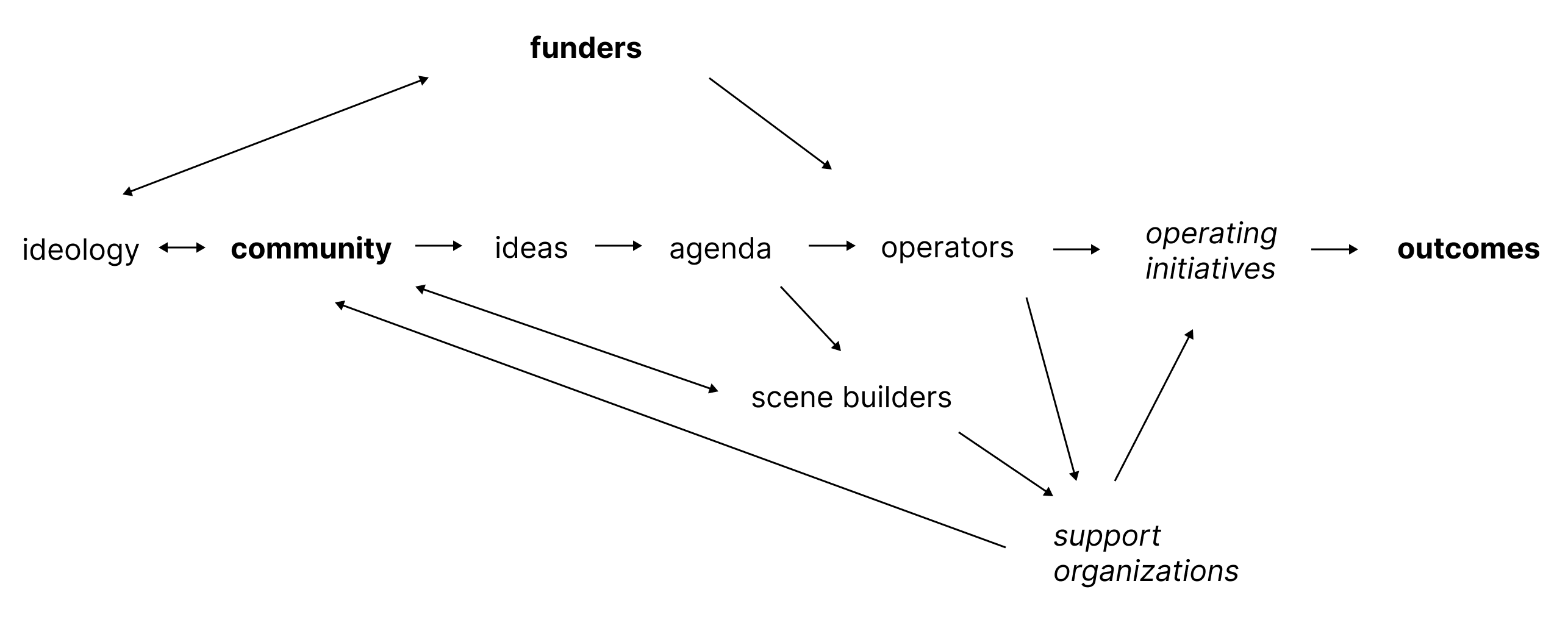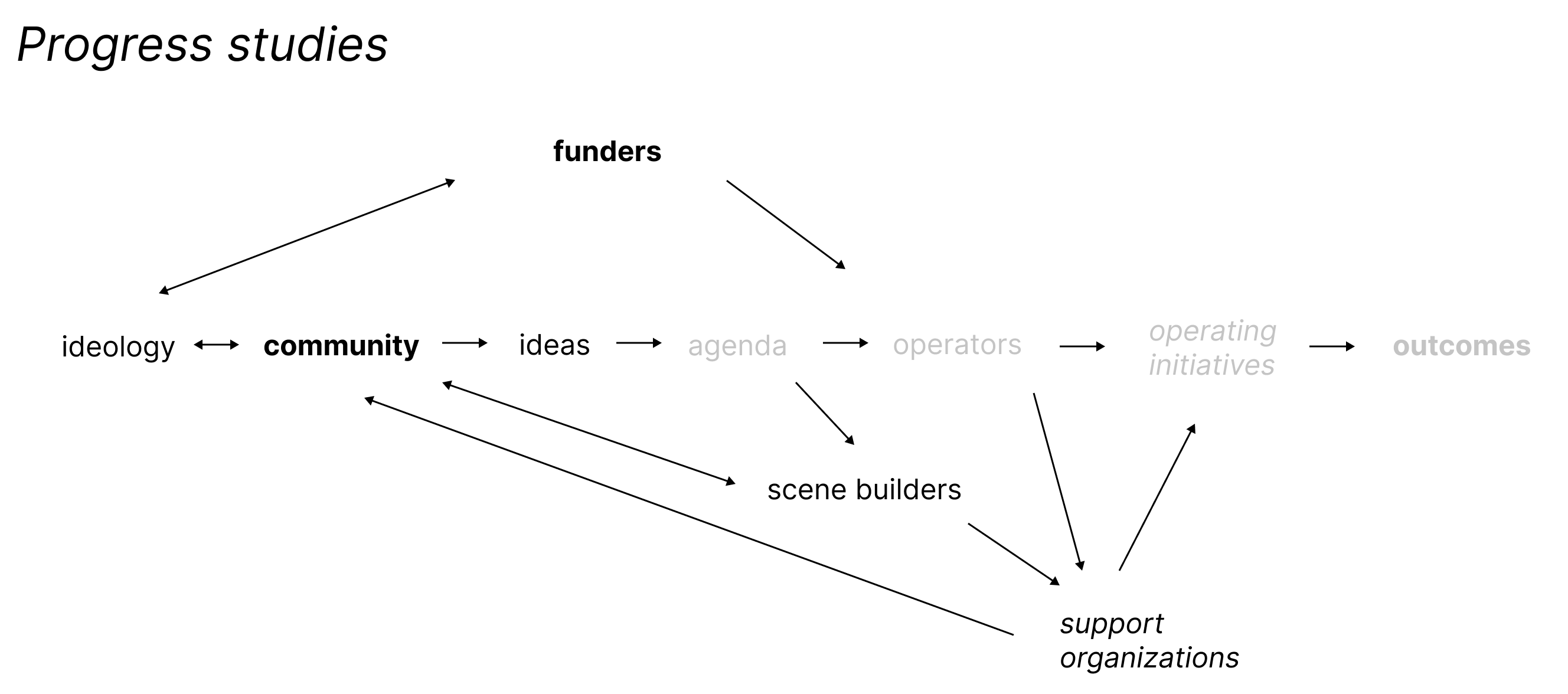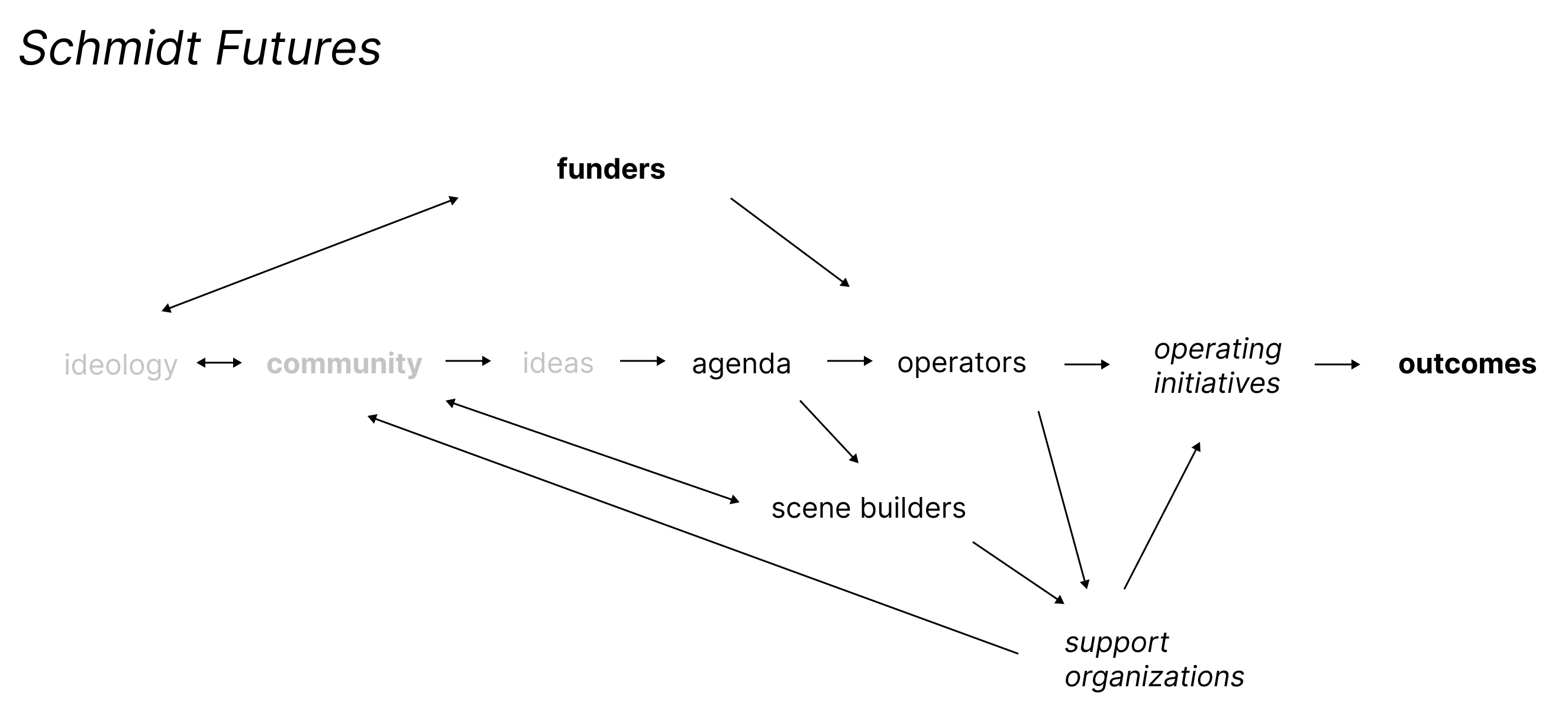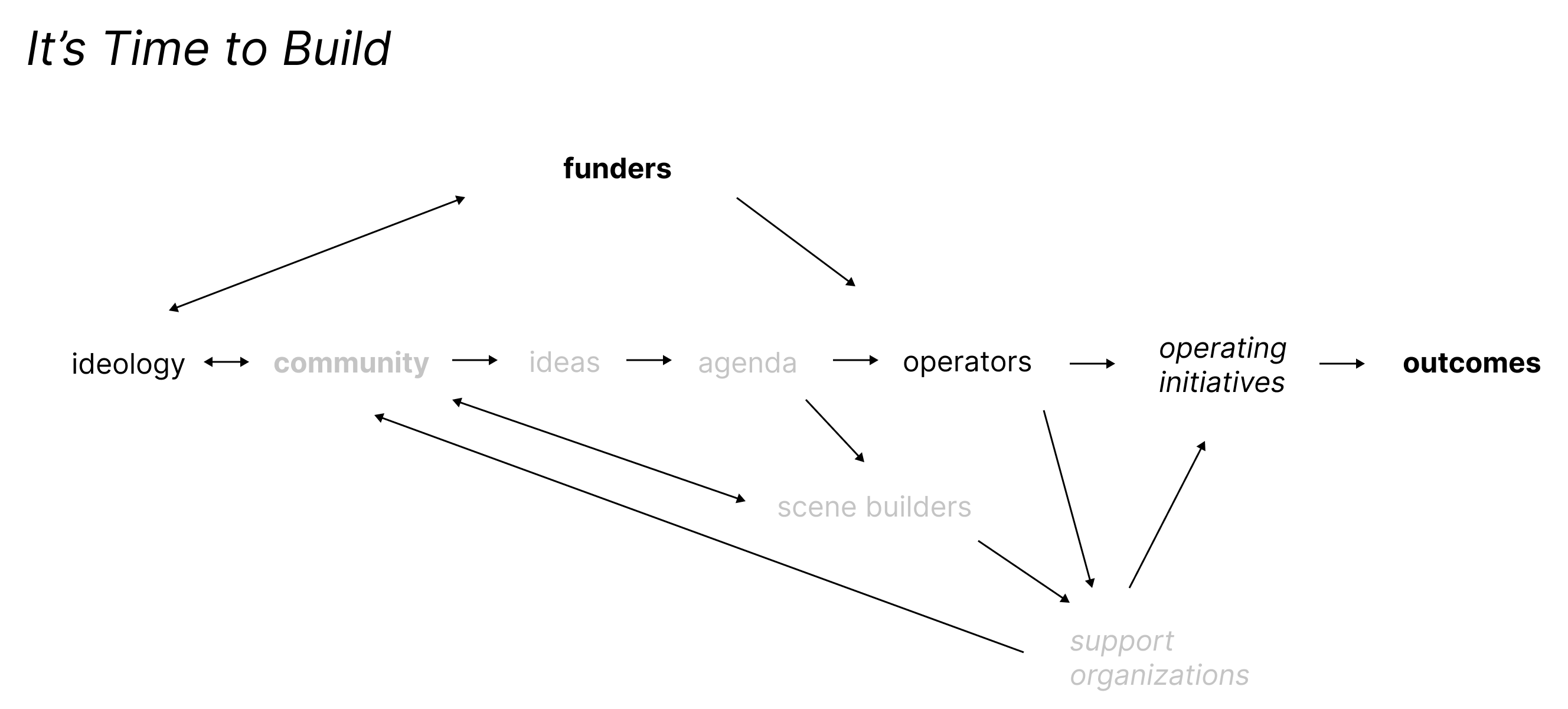Tech as a system of values, and not just an industry, is heavily driven by its subcultures and their ideologies. Where do these ideologies come from, and how do they influence what’s accomplished?
One of the most visible ideologies in tech is effective altruism (or EA), a philanthropic school of thought that advocates for “us[ing] high-quality evidence and careful reasoning to work out how to help others as much as possible.”. If you don’t buy into its philosophy, it’s easy to write off effective altruism as yet another eccentric subculture. But effective altruism is both less and more interesting than it seems.
Although I’m not an EA, I think effective altruism is a useful blueprint for understanding a growing number of influential subcultures in tech right now, from progress studies to It’s Time to Build to crypto public goods funding. EA is the strongest example of what I think of as an Idea Machine: a network of operators, thinkers, and funders, centered around an ideology, that’s designed to turn ideas into outcomes.
Effective altruism’s strength lies in its infrastructure, which we can use to better understand how other idea machines work, what their impact will be, and what’s needed to make them more effective.
The limitations of effective altruism
Firstly, I want to address why effective altruism, as I’ve stated elsewhere, “cannot singlehandedly meet the civil purpose of philanthropy.” In other words, if effective altruism is so good already, why do we need other idea machines at all?
I think of philanthropy as a type of idea marketplace for public goods, funded by private capital. Like all idea marketplaces – startups, media, philosophy – it’s inherently pluralistic. We don’t have a single government-funded media channel, for example, but instead get our news, entertainment, and ideas from a multitude of sources.
There are certainly better and worse ways of executing a philanthropic initiative, just as there are better and worse ways of building a startup. But once we look beyond best practices, there’s way more variance in approaches than, say, effective altruism might advocate for.
We seem to understand that entrepreneurship operates in a free market of ideas, so I’m not sure where the idea comes from that there is, or could be, One True Approach to philanthropy. I’d guess it’s because there are so many egregious examples of mismanaged funds and middling outcomes, which have led people to feel understandably suspicious about its effectiveness. []
If we were to take EA literally, however, we’d be saying that there is an objectively best way to accomplish these outcomes, and that that way is discoverable: that complex social problems are a finite, solvable game.
If philanthropy is pluralistic – and, like any idea marketplace, that is one of its virtues – then there is no single school of thought that can “solve” complex social questions, because everyone has a different vision for the world. If you’re pro-pluralism in startups, you should also be pro-pluralism in philanthropy.
The scholar Peter Frumkin describes philanthropy as having both instrumental and expressive value. Effective altruism can be understood as a movement that heavily prioritizes instrumental value (which, ironically, is its own form of self-expression). As a private citizen, renouncing my right to expressive value, in favor of donating to wherever GiveWell tells me to, feels like I might as well just pay more taxes to the government. Why have a market of choice if we can’t exercise it?
I expect that effective altruism will always be an example of what I’ve called “club” communities elsewhere: high retention of existing members, but limited acquisition of new members, like a hobbyist club. EA will continue to grow, but it will never become the dominant narrative because it’s so morally opinionated. I don’t think that’s a problem, though, because ideally we want lots of people conducting lots of public experiments.
Why aren’t there more effective altruisms?
The more interesting question, then, is: why aren’t there more effective altruisms? It’d be like if there were just one startup, or one blogger, or one news channel. When it comes to deploying private capital towards public outcomes, the idea marketplace is woefully barren.
Although I don’t personally identify with the ethos of effective altruism, I also think they’ve done a lot of things well. EA has a remarkably good infrastructure for attracting and retaining members, identifying cause areas, and directing time and dollars towards those efforts. A common critique of EA is that it fails to attract operational talent, but despite its weaknesses, it’s still the best example of what I’ve been calling an “Idea Machine” in my head – maybe not the best term in the world, but let’s roll with it because I’m bad at naming.
An Idea Machine is a self-sustaining organism that contains all the parts needed to turn ideas into outcomes:
- It starts with a distinct ideology, which becomes a memetic engine that drives the formation of a community
- The community’s members start generating ideas amongst themselves
- Eventually, they form an agenda, which articulates how the ideology will be brought into the world. (Communities need agendas to become idea machines; otherwise, they’re just a group of likeminded people, without a directed purpose.)
- The agenda is capitalized by one or several major funders, whose presence ensures that the community’s ideas can move from theory to practice – both in terms of financing, as well as lending operational skills to the effort. (Without funding, an idea machine is just that: an inert system that needs fuel to turn the crank and get it moving.)
As community members move from ideas to action, they might become scene builders, who help sustain the community, develop the agenda, and attract new members; or operators, who drive the operating initiatives that lead to outcomes – the ultimate purpose of the entire machine. Both types might also lend a hand to create support organizations, whose purpose is to strengthen the values and best practices of the idea machine.

To use effective altruism as an example, EA’s idea machine derives from its eponymous ideology, which has roots in utilitarianism and rationalism. Its community was incubated at Oxford University and LessWrong, and further bolstered by organizations like GiveWell and Oxford’s Centre for Effective Altruism (which houses 80,000 Hours and Giving What We Can).
Dustin Moskovitz and Cari Tuna joined as major funders (via Good Ventures) in the early 2010s, which helped turn effective altruism from a philosophy into the machine it is today – not just with dollars, but also through meaningful support (for example, incubating Open Philanthropy). Moskovitz and Tuna got involved after meeting Holden Karnofsky, cofounder of GiveWell; Tuna had recently read Peter Singer’s The Life You Can Save, a utilitarian treatise that influenced her interest.
An Idea Machine is adept at attracting newcomers and pushing them towards outcomes. If someone says “I’m interested in effective altruism, where do I start?”, there are many clear entry points with concrete ways to think about one’s career, how to spend one’s income, and how to get involved in EA’s community. One can imagine a robust “menu” of action items for a prospective EA, from tithing their salary (low-touch) to working for, or starting, an organization that tackles one of its cause areas (high-touch).
Effective altruism’s cause areas have been largely shaped and developed by its community, including the EA Global conference and the EA Forum. While there’s some evidence to suggest that EA began to mature and stagnate in the late 2010s, the appearance of another new major funder, Sam Bankman-Fried, has breathed new life into the machine – although I’d argue that SBF’s involvement could branch into a new machine in itself (see next section).
Emerging examples of Idea Machines
In recent years, it seems like we are starting to see more effective altruisms being built. Here are a few emerging examples I’ve noticed:
- Schmidt Futures (Eric Schmidt, 2017)
- Public goods funding - an Ethereum-flavored meme that includes quadratic voting, retroactive public goods funding, etc (Vitalik Buterin, Kevin Owocki, Glen Weyl, 2018)
- Bentoism (Yancey Strickler, 2019)
- Progress studies (Patrick Collison + Tyler Cowen, 2019)
- It’s Time To Build (Marc Andreessen, 2020)
- Future Fund (I think of this as “EA (SBF’s Version)”, 2022)
I’ve intentionally highlighted examples of idea machines at various sizes and stages of development to demonstrate that it’s not about how well-funded or robust they are, but rather that all these clusterings have a similar shape to them.
Truthfully, all of these operations are still quite small and toylike. But EA has been around since 2009, and is understandably much more mature and developed. [] Give these newer machines a few years, and they might look very different.
We can use our previous framework to better understand which stages of development these machines are in, and how they could become more effective. For example:

Progress studies is a philosophy and community that’s just starting to build its first support organizations (ex. Roots of Progress, Works in Progress), but hasn’t yet developed an agenda or operating initiatives to cross over from the ideas -> action pipeline (an exception is The Institute For Progress).

Schmidt Futures is sort of the inverse. It has an agenda, excellent infrastructure, and funding to translate operators and their initiatives into outcomes (ex. Convergent Research and focused research organizations, or FROs), but spends less time on articulating a particular philosophy or community.

It’s Time to Build has an ideology and funding, which appears to be exclusively executed through startups [], but it doesn’t seem to have a clear agenda (American Dynamism is a step in this direction). Nor does it have a legible community, support organizations, or scene builders (a few exceptions might be the Good Time Show and Future), which I think will limit its ability to build long-term cultural impact.
We can also use this framework to identify potential opportunities for new idea machines:
- Balaji Srinivasan’s theory of the network state is a philosophy with the beginnings of a community around it, which could become an idea machine if they develop an agenda and attract funding
- Reboot and Praxis are communities with strong philosophies that, with an agenda and major funders, could evolve into idea machines (they can also just be communities, and that’s fine too!)
Idea machines are different from movements, which are focused on achieving a specific outcome and are therefore self-limiting (if they succeed, the movement winds down). For example, YIMBYism and climate change are movements that attract operators with shared values, but on the basis of wanting to address a specific problem, rather than a philosophy that transcends the problem itself. Movements can be fed into an idea machine, however, to accelerate their impact.
On the other end of specificity, idea machines are less broad than paradigm shifts, which are widespread, headless, decentralized shifts in cultural norms and attitudes due to changes in systemic conditions. For example, web3 is a paradigm shift, but it’s too big and distributed to be an idea machine.
Finally, idea machines are distinct from personal philanthropic activity. Jeff Bezos and Elon Musk are both cults of personality who also have made various philanthropic plays, but neither has an idea machine (that I can discern, anyway) (yet!). Marc Benioff is an active philanthropist, but appears to follow a classic progressive agenda; his activity stems from a closed peer circle, rather than a distinct ideology.
Idea Machines in previous historical forms
Idea machines are not new, but the form in which they appear is changing. For most of the 20th century, the home for idea machines was foundations, first popularized by John D. Rockefeller in the 1910s.
Foundations took several more decades to incubate, as a newly minted class of professionals built an industry around the business of translating ideas into action. Rockefeller firmly believed that foundations would “attract the brains of the best men we have in our commercial affairs, as great business opportunities attract them now.”
By the mid-20th century, foundations had reached the height of their power and influence, triggering a congressional investigation into whether foundations were manipulating public opinion and thought. The lawyer Rene Wormser, who wrote the final report, described foundations as a “cartel” that threatened to direct our entire intellectual and cultural life. Large foundations like the Ford Foundation, Commonwealth Fund, Russell Sage Foundation, and various Rockefeller and Carnegie initiatives were investigated for developing and promoting their own agendas, spreading “propaganda” with political aims, and influencing public policy.
It took another nearly two decades for the United States government to successfully hamstring foundations, but they finally did, with the 1969 Tax Reform Act that introduced all the paperwork we associate with foundations today: public reporting requirements; minimum 5% annual endowment spend; and strict limitations on political influence, among other stipulations.
The federal regulation of foundations didn’t mean the death of idea machines, however. It just meant that that foundations were no longer the best place to house them. It’d be like if the government decided to heavily regulate Delaware C Corps: if it were bad enough, founders would stop using them for startups, but they’d eventually find some other way of accomplishing the same thing.
How are today’s idea machines different?
The modern Idea Machine better reflects how people self-organize today. They are decentralized, more closely intertwined with public dialogue, and work symbiotically with a community that anyone can join: many individual nodes operating in a loosely-organized network, instead of a monolithic organization.
In today’s idea machines, an ideology serves as the coordination mechanism for ideas – as foundations once did – making it easier for both sides to find each other. It attracts operators who resonate with its ethos and have ideas for how to bring it into fruition. On the other end, it also attracts (or is even initialized by) funders who want to bring that vision into the world. Funders have varying levels of involvement with their own machines; in some cases, the underlying ideology takes hold as a meme, and influences the machine’s direction more than the funders themselves.
The traditional foundation has its advantages: namely, the ability to build institutional memory and commit to long-term agendas, thanks especially to an endowment structure, which obviates the need to continuously fundraise.
However, foundations also suffer from high overhead and organizational decay over time. They are prone to principal-agent problems, where the goals and interests of foundation professionals don’t always align with the original donor’s intent. Because foundations can exist into perpetuity [], they can even be usurped and weaponized towards other goals. Foundations in the 1950s and 1960s epitomized this problem: the activities undertaken by major foundations took place well after their original donors were no longer living.
With a more decentralized structure, modern idea machines can “arm the rebels” right where they are, instead of hiring them into a foundation. The popularity of so-called regrantor programs (i.e. scout programs) reflects this trend, where talented individuals are given funding to make grants on behalf of the grantmaking organization. And because idea machines are built upon the strength of their ideology, they only last as long as the ideology lasts.
While idea machines with a single wealthy benefactor get most of the attention, they can theoretically be capitalized in different ways. (This is equally true of foundations: private foundations are capitalized by a single source of wealth, but there are also corporate and community foundations.)
DAOs are an example of idea machines that can be initialized by a community. It may require more work to raise the funds and awareness to capitalize an idea machine without a major funder, but once they are initialized, DAOs must adopt similar tactics – develop an agenda, spin up and fund support organizations, invest into scene building, attract operational talent – in order to be effective.
It’s hard to know whether the current, loosely-organized form of idea machines is its terminal state, or an inchoate form of something else (like DAOs), not unlike Rockefeller’s vision for “Benevolent Trusts,” which were a precursor to modern foundations. It has already become common for philanthropic funds in tech to operate as LLCs instead of 501c3 foundations, and it’s possible that a new legal vehicle will emerge.
Regardless of its ultimate form, modern idea machines feel like a clear evolution away from 501c3 foundations. They are more focused on narratives and scene building, on attracting talent by spreading ideas, and on doing so in a public forum rather than within the walls of an organization.
More idea machines are good for everyone
A pessimistic read of idea machines might be that, given the massive influx of tech and crypto wealth, perhaps we are heading towards a dystopian world in which everyone is an e-serf of a billionaire with an agenda. But, I’m an optimist, so I’m gonna try to make a case for why I think more idea machines are good for the world.
Until recently, idea capital in tech was constrained, and mostly only accessible by startup founders. If you had an idea for improving public society that required money and talent to execute, and you didn’t do it as a startup, you either had to get the EA community to care about it, or – as the old joke goes – convince Peter Thiel to fund it. [] Effective altruism and the Thielverse (tech’s OG idea machine) had a near-monopoly on idea capital.
Constrained capital is a common problem in philanthropy more broadly: grantees tend to operate in a zero-sum mindset because they’re competing for the same small number of funders (sometimes, just one or two), whereas startups have an abundance mindset because there are many funders available.
A flurry of liquidity in the last five years, as well as a strong bull market, meant that idea capital became cheaper and more plentiful, even with the current downturn. [] What’s more, that wealth has also become much more widely distributed, thanks to new financial innovations (i.e. employee equity grants, which have only gotten bigger, and crypto). Yes, the number of people who are extremely wealthy in the world is still small, relative to the general population. But there are also way more of them than ever before, and they don’t all fit a typical founder-or-executive profile anymore, either.
In a world where there are many wealthy people, then, and many more types of wealthy people, there are also more idea machines, and a more liquid idea marketplace. [] If you’re an “idea operator”, instead of having to beg one of two funders to take your idea seriously, you now have many more potential options to shop around to. (This evolution is not dissimilar to what happened to startups, as venture capital became more widely available.)
Here are a few examples of movements that were helped or hindered by the availability of idea machines. Note that it’s possible for one idea to exist across multiple idea machines, and that machines can and frequently do collaborate with one another:
- Charter cities previously lived in Thiel’s idea machine under the label of seasteading (they failed to gain buy-in from EA), then languished for a few years without a home. More recently, they’ve found a new home under the banner of progress, and arguably could find an even better home in the network state, if it ever becomes an idea machine.
- Metascience (i.e. “how do we improve science”) had a community, but no funding, so it languished for years in the realm of “good idea, but what would we actually do about it”. Since finding a home in Schmidt Futures and progress studies, metascience has moved much more quickly towards outcomes.
- Tools for thought still suffers from insufficient funding (perhaps best encapsulated by Dynamicland’s history). It has a community, talent, and philosophy attached to it, but until it finds an idea machine, it will be unable to realize its full potential.
To those who say, “Well, wouldn’t it be better if the person with good ideas had been the one to get fabulously wealthy instead?” – sure, but in the same way that a founder wants to focus on building their company, not being an investor, sometimes “idea operator” types aren’t the same people who have eight-to-ten-figure startup outcomes. In this world, both sides get to excel at doing the things they want, while also benefiting from each others’ skills and interests.
Despite the recent growth, there are still not nearly as many idea machines as there should be. If we see more idea machines appear over the next few years, it can be good for everyone – which is why we need more options besides just effective altruism. It certainly beats a world in which there are many good ideas, but no capital available to transform them into outcomes. As more machines emerge, I’m hopeful that every person with a good idea can find an idea machine that works for them.
Thanks to Toby Shorin and Bryan Lehrer for many conversations that helped clarify these ideas.
Notes
from Hacker News https://ift.tt/18DVfLr
No comments:
Post a Comment
Note: Only a member of this blog may post a comment.